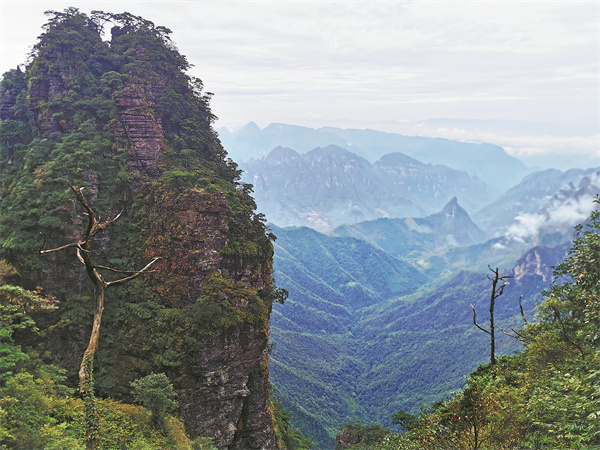
A pine tree grows atop the Shengtang Mountain.[Photo provided by Chen Liang/China Daily]
Winter is often an offseason for hiking enthusiasts living in northern China. Covered in snow, most mountain sites known for their hiking routes in the northern part of the country are closed because of concerns about tourist security and fire prevention.
Especially this year as heavy snow and icy conditions have contributed to more falls and fractures in many northern cities.
Fortunately, China is a big country. For anyone wanting to hike on a beautiful mountain in the winter, there is always the south.
Located in the northern part of the Guangxi Zhuang autonomous region, Jinxiu Yao autonomous county is hidden in the rolling Dayao Mountains and offers visitors quite a few attractions and pleasant hiking routes all year around.
To reach the county, I chose to fly into Guilin in northern Guangxi from Beijing on a Thursday morning last month, pick up a car at the airport and drive to Jinxiu.
Jinxiu is more than 200 kilometers south of Guilin under the jurisdiction of Laibin city. The drive was pleasant as the region around Guilin is known for its karst scenery that is a staple of classical Chinese landscape painting. For an hour, it was like driving in a scroll painting featuring green karst pinnacles with clear streams curving through dense bamboo groves.

Shengtang Mountain, a major attraction in Jinxiu Yao autonomous county, Guangxi Zhuang autonomous region, offers visitors majestic views.[Photo provided by Chen Liang/China Daily]
The karst rock formations then became scarce as I entered the Dayao Mountains, an area known for its dense subtropical forests and rich biodiversity. A nature reserve named after the mountain was established in 1982 and was upgraded to a national-level nature reserve in 2000.
Driving on the winding road, you still can see many sheer rock formations. They rise to form the countless peaks of the mountain range concealed within a veil of clouds.
The county town of Jinxiu, nestled in a breathtaking backdrop of majestic mountains, is one of the smallest county seats in Guangxi. Jinxiu River runs through the town and pours into a lake at the entrance of the town.
After driving for nearly three hours, the sight of a lake encircled by a roofed plank road was reassuring to me. I drove onto the street along the Jinxiu River and saw stone pavilions on the banks and small bridges spanning the river. Most buildings on both sides of the river have a classical style featuring tiled roofs and flying eaves.
It's a truly beautiful hillside town.
I checked into the Pangwanggu Hotel at one end of the town. A five-star riverside hotel boasting hot springs, a lush garden and beautiful views of the mountains, it offers discounted standard rooms for just a little over 300 yuan ($42). Believe me, it's worth every cent.
Lianhua Mountain
I chose to visit Lianhua Mountain scenic area the next morning. About 16 km northwest of the county town, it features a hiking route winding around a cluster of peaks shaped like a lotus. Each peak stands like a lotus petal. As a result, the mountain is named lianhua, meaning "lotus".
With a summit 1,350 meters above sea level, a local friend told me that Lianhua Mountain is like the little brother of Shengtang Mountain, the summit of the Dayao Mountains, which has an elevation of nearly 2,000 meters.
"You need barely half a day to climb Lianhua Mountain and a whole day to scale Shengtang," he said. "So I always recommend people visit the former first as it can be a good warm-up."
A stone slab lane leads into the mountain. At the beginning, it's quite flat and gentle and curves through lush subtropical forest. Exotic plants grow rampant along the route. Even in the early winter, I saw a few flowers along the road.
After about half an hour's climb, I saw the first stone pinnacle rising before me. The path goes down and then up, and becomes narrow to squeeze through the crevice between the rock formation and the sheer cliff. Soon I found myself walking into a maze created by rock formations, the mountain path, towering trees and a scarf of clouds.
The scenery was dramatic and breathtaking.
At times when the cloud drifted away, I could get bird's-eye views of valleys and villages at the foot of the mountain. Gradually, my legs felt the pressure from scaling the stone steps.
The mountain path gracefully meanders upward, forming a picturesque circuit that winds its way around rock pinnacles. Following the route, I could immerse myself in the peace and beauty of nature for three hours.
For the afternoon, my friend recommended Cathaya Pine Tree Park, a scenic area featuring a forest of huge Cathaya argyrophylla trees, or Cathay silver fir, growing on a mountain. But I chose to stay in the hotel to rest and conserve my energy for a hike up Shengtang Mountain the next day.
Shengtang Mountain
Compared with the easy and pleasant walk in Lianhua Mountain, to reach the summit of the Dayao Mountains is quite a challenge.
According to my local friend, the starting point of the hiking trail in Shengtang Mountain is around 1,190 meters above sea level. The summit has an elevation of 1,979 meters. There is a hotel on top of the mountain. If visitors choose to stay in the hotel for a night, they can drive their own cars from the entrance of the scenic area to the starting point of the hiking trail. Yes, you read it right, you have to climb to the mountaintop to stay at the hotel.
I didn't want to carry a heavy backpack to scale the mountain. So I chose to reach the scenic area and catch the first shuttle bus from the entrance to the starting point of the hike at 8 am.
The ride took me about half an hour. On the bus, I could see the sheer mountaintop towering above the clouds. It was both tantalizing and intimidating.
I started my climb at 9 am. The stone path is quite steep and ascends quickly. As you climb, your breath quickens and your heart rate accelerates. I chose to stop from time to time to admire various plants, including a rich variety of trees and shade plants, and look for flowers.
After about one hour's climb from the starting point, there is a fork in the path. The left path leads to the Yunhai (Sea of Clouds) Hotel on the top of the mountain, which is a slightly shorter path, but steeper. The path to the right is a longer route, but offers more spectacular views, according to my friend.
I chose the longer route.
Soon I found myself walking on a path built in the middle of a huge cliff. Deep valleys and forest canopies were below my feet; rock formations in various shapes on which some huge trees stood erect were right before my eyes. The views were just fantastic.
I walked steadily and tried to give myself more time to enjoy the scenery. The path then led me into a forest of some special pine trees. With thick and bent trunks and branches and small leaves, Podocarpus macrophyllus, aka the Buddhist pine or the Chinese yew tree, is native to the mountainous areas of China and Japan.
It is an evergreen conifer that typically grows as a narrow, conical tree. Because of the beautiful shapes it can assume, the tree is often used to decorate gardens and create bonsai displays. Because of its commercial value, the trees were heavily poached from the wild in the 1980s and became endangered.
On Shengtang Mountain, the core area of the Dayaoshan National Nature Reserve, however, the trees have flourished because of strict conservation.
Taking the route to the right leads hikers into a wood of Buddhist pines. Already about 1,700 or 1,800 meters above sea level, I could feel clouds drifting in the wood and listen to the whistling of the wind in the pines. It was so serene that I truly forgot the hustle and bustle of daily life for some moments.
Continuing to climb, I walked out the wood and into the mixed forest of short bamboos and another species of towering pine trees.
Around noon, I finally arrived at the first lookout platform atop the mountain. From this vantage point, I marveled at the sight of an immense pine tree, its branches and canopy unfurling like a fan in front of my eyes. Beyond the tree, a sea of clouds appeared to hover, with a handful of peaks seemingly floating above this ethereal expanse.
The sky was painted a brilliant blue, and the gentle sunshine enveloped me in warmth. As I surveyed my surroundings, I discovered more pine trees and peaks, creating a truly flawless panoramic view.
Up the trail, there is another lookout platform and then, a side road down to the hotel. After the fork, the path reaches a pavilion atop the mountain. I savored each precious moment, basking in the warm sunshine and feasting my eyes on the breathtaking vistas, a well-deserved reward for managing the arduous ascent.
After a quick lunch in the hotel courtyard, I started descending along the left route. It was quick but steep and truly tough on my knees.
I finished the 11-kilometer circuit at 4 o'clock in the afternoon. Although exhausting, the hike was truly rewarding.














